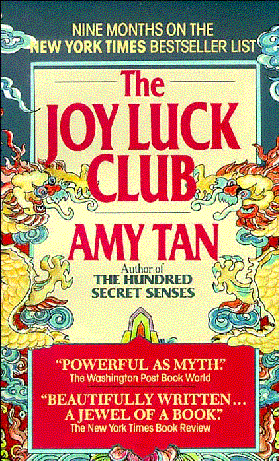The Joy Luck Club
Amy Tan
Fiction
Reviewed By: NinjaUsagi
Review posted: 03/19/04
Yes, there's a movie out there, but this is a review of the book it was based from. That being said, I will make no illusions. This is not a happy book. People have lived hard lives, lost family members, had marriages fail. There's a sadness and depression that pervades everything. Yet underneath it all, there is a hope that the story's mothers have for their children.
 The book centers on the lives of four Chinese women and each woman's grown daughter. The story begins shortly after the death of one of the mothers, and her daughter taking her place in this web of families' Joy Luck Club. The mothers and fathers feast on food, they discuss what to do with the Club's investments, and then the men and women go do their own things. For the women, it's playing mahjong. This is where the one daughter learns that the twin sisters she thought were lost back in China had been found, but she must go to tell her sisters that their mother is now dead. The women all in turn remember their lives before coming to America, or growing up here, as well as their current problems.
The book centers on the lives of four Chinese women and each woman's grown daughter. The story begins shortly after the death of one of the mothers, and her daughter taking her place in this web of families' Joy Luck Club. The mothers and fathers feast on food, they discuss what to do with the Club's investments, and then the men and women go do their own things. For the women, it's playing mahjong. This is where the one daughter learns that the twin sisters she thought were lost back in China had been found, but she must go to tell her sisters that their mother is now dead. The women all in turn remember their lives before coming to America, or growing up here, as well as their current problems.
To the mothers' stories, there's an almost myth-like quality about how they got out of an arranged marriage, or fell off a riverboat during a festival. Each woman comes to America looking for a better life for herself and the child she will have. The daughters all have troubled or failed marriages, compounded with growing up with difficult relations with their mothers. Knowing that the mothers went through so much anguish makes the daughters' troubles all the more sad; the daughters have learned nothing from their mothers' pasts. They must all struggle, especially with what it means to be Chinese and/or American.
Tan includes an incredible amount of characters. Sure, this can allow for a lot of different storylines, but Tan does a sort of round-robin chapter style, rather than dealing with one set of characters at a time. With 8 (well, 7) main characters, perspectives changing from chapter to chapter, plus all the supporting characters, it was hard to remember "Ok, who was this character? What is her problem? Who was her mother?" I ended up having to keep a list of the main characters and at least the basic plotlines for each.
Still, Tan's writing style is rich with imagery and emotion. I did enjoy this book, but maybe I'm just a sucker for melancholy, as long as it's well-written.
|




 The book centers on the lives of four Chinese women and each woman's grown daughter. The story begins shortly after the death of one of the mothers, and her daughter taking her place in this web of families' Joy Luck Club. The mothers and fathers feast on food, they discuss what to do with the Club's investments, and then the men and women go do their own things. For the women, it's playing mahjong. This is where the one daughter learns that the twin sisters she thought were lost back in China had been found, but she must go to tell her sisters that their mother is now dead. The women all in turn remember their lives before coming to America, or growing up here, as well as their current problems.
The book centers on the lives of four Chinese women and each woman's grown daughter. The story begins shortly after the death of one of the mothers, and her daughter taking her place in this web of families' Joy Luck Club. The mothers and fathers feast on food, they discuss what to do with the Club's investments, and then the men and women go do their own things. For the women, it's playing mahjong. This is where the one daughter learns that the twin sisters she thought were lost back in China had been found, but she must go to tell her sisters that their mother is now dead. The women all in turn remember their lives before coming to America, or growing up here, as well as their current problems.